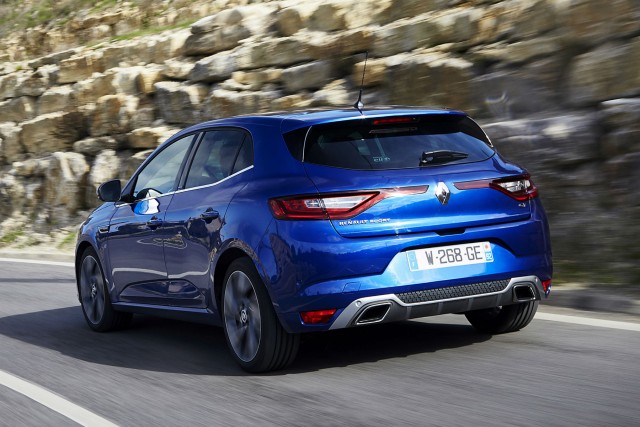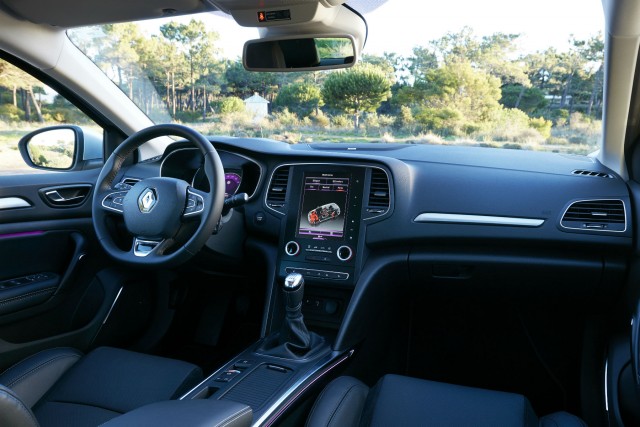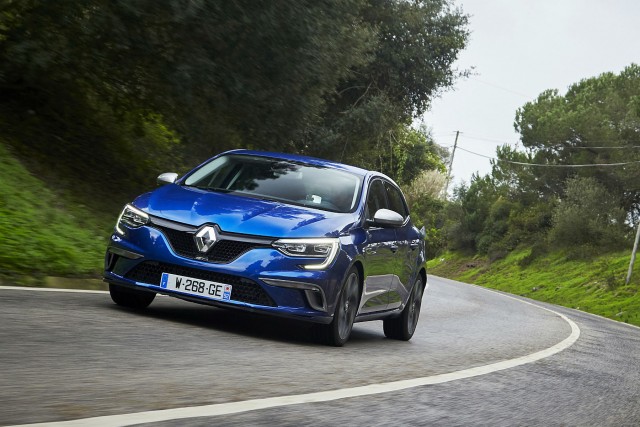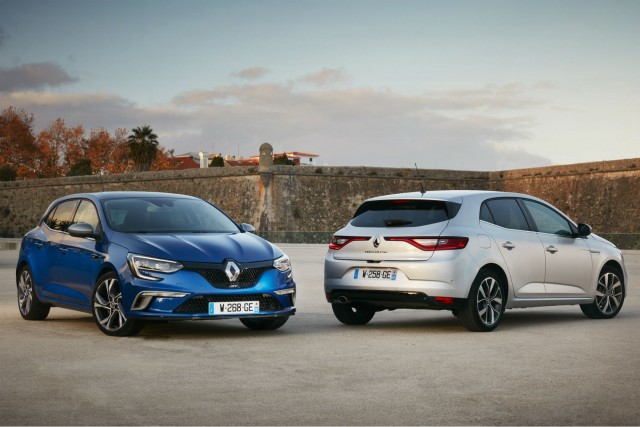Six months before it goes on sale, we’re among the first to drive the 2016 Renault Megane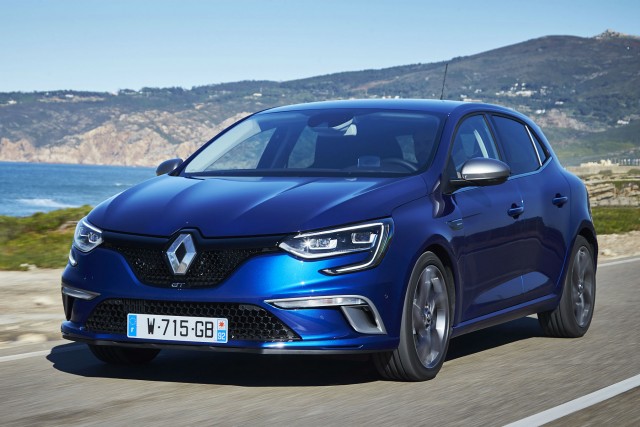
Overview
A decade ago, the second-generation Megane was ‘shaking that ass’ while shaking up the sales charts. Since then, Renault’s mid-sized hatchback has gone from one of Europe’s best-selling cars to an also-ran, dogged by bland styling, a low-rent interior and a poor reputation for reliability.
The fourth-generation Megane you see here won’t actually reach UK showrooms until June 2016, but we bagged an early drive at the international launch in Portugal. One thing is for certain: it may not have a bustle-shaped boot, but Renault has ditched the dull design. Has the Megane finally got its groove back?
If the new Megane looks striking in photos, it’s even more so in the metal. Longer, wider and lower than the car it replaces, it looks sleek and sporty – even in standard non-GT spec. Huge front and rear lights – both with distinctive LED ‘signatures’ – add a pleasingly premium touch, too.
Renault will longer sell three-door ‘Coupe’ or CC cabriolet versions of the Megane, citing insufficient demand (apparently many buyers have migrated to crossovers). So the range is five-door-hatchback-only at launch, with an estate version following in the autumn.
Inside, the Megane’s big selling point is a huge, portrait-oriented touchscreen. It’s not quite a budget Tesla, but you get the idea. ‘Virtual’ TFT instuments can be configured to the driver’s personal taste, while available safety equipment includes adaptive cruise control, automatic emergency braking and self-parking. The Megane has already scored a maximum five stars in Euro NCAP crash tests.
Engines for the UK are yet to be confirmed. However, the petrol line-up is likely to start with the 100hp 1.2 TCe, then 115hp 1.2 SCe (non-turbocharged), 130hp 1.2 TCe and a 205hp 1.6 TCe – the latter in the range-topping GT. Diesels will probably kick off with the 90hp 1.5 dCi, then 110hp 1.5 dCi, 130hp 1.6 dCi and 165hp 1.6 dCi.
Most Meganes will come with a six-speed manual gearbox (five speeds on the 115hp petrol). Renault’s semi-automatic ‘flappy paddle’ EDC ’box is offered on the 130hp petrol and 110hp diesel – and standard with the most powerful engines of each fuel-type.
Frustratingly, Renault won’t confirm prices until closer to the car’s on-sale date either. However, we expect the car to be closely competitive with the Ford Focus and Vauxhall Astra, which means a start-price of around £15,500.
On the road
We start our test-drives in the Renaultsport GT, the flagship ‘warm hatch’ until the hot Megane RS arrives – probably in 2017.
This is the first time Renaultsport has lent its well-respected name to anything other than a full-fat hot hatch and there is a strong risk of diluting the brand. To help avert that risk, the GT has specially tuned suspension and – uniquely in this class – rear-wheel steering.
This ‘4Control’ system turns the rear wheels slightly in the opposite direction to the fronts to sharpen up the handling. Its effect is immediately noticeable on the road; in tight bends, the GT almost seems to pivot around its axis, catapulting you out of corners with impressive ease.
Unfortunately, the rest of the GT package is less well-rounded. Its ride is jittery over the sort of broken bitumen that swathes most British B-roads, the EDC gearbox is clunky on downshifts and its steering feels twitchy – especially in Sport mode. Despite its twin exhausts, the 205hp 1.6 turbo petrol engine sounds muted and rather characterless, too.
Thankfully, things improve on day two with the Megane 1.6 dCi. With smaller 17in wheels – the GT wore optional 18-inchers – and softer suspension, this car feels far more comfortable in its own skin. Ride quality is much improved, and the torquier 130hp diesel engine means it doesn’t feel much slower on the road (0-62mph takes 10.0 seconds, versus 7.1 seconds for the GT).
Indeed, the Megane diesel seems to have most bases covered. It’s a refined and comfortable cruiser with enough dynamic talent for when the Tarmac gets twisty. A Ford Focus is ultimately more fun, but the latest Megane runs it fairly close.
On the inside
The Megane’s dashboard is dominated by a central tablet-style touchscreen. This measures seven inches across and is landscape-oriented on entry-level models; higher-spec cars get the 8.7-inch portrait-style screen seen here.
Renault says this is the ‘largest touchscreen in the non-premium class’, but is bigger necessarily better? We’re not sure. There’s no doubt the R-Link 2 system is easy to use, with bold graphics and intuitive menus. But the screen’s depth means frequently taking your eyes off the road – and there’s no supplementary joystick-style controller, such as that offered by Mazda. At least the optional colour head-up display helps avoid such distractions.
There are still a few cheap plastics in the Megane’s cabin, but it’s a vast improvement over the outgoing car. We’d put it on par with a Ford Focus for perceived quality. Particular attention has been paid to the bits you touch – steering wheel, gear lever, door pulls –which all feel pleasantly premium.
A special mention must also go to the Megane’s seats, which are the same as found in the larger Espace and Talisman models (neither of which is sold in the UK). They’re supportive and very comfortable, while the Alcantara (artificial suede) trim on GT models looks great.
Low-slung styling hasn’t unduly compromised space in the back; the car can still accommodate five adults in relative comfort. And the 434-litre boot is one of the largest in class. For comparison, a VW Golf holds 380 litres.
Running costs
As noted previously, we don’t have list prices for the Megane yet. However, the car is likely to be a couple of thousand pounds cheaper than an equivalent VW Golf, for example. And if past form is anything to go by, Renault dealers won’t be averse to offering a discount. That said, if you plan to buy on finance, likely stronger residual values for the Golf could narrow the gap when it comes to monthly payments.
What about reliability? Well, early Meganes were pretty dismal in this regard, but Renault insists this has been one of the priorities for the new car. Its four-year/100,000-mile warranty is also better than the three-year/60,000-mile deal of many rivals.
In terms of fuel economy, the undisputed champ is the 110hp 1.5 diesel in Eco2 guise, which returns 85.6mpg and tax-dodging CO2 emissions of just 86g/km. The standard 110hp diesel achieves 76.3mpg and 95g/km, while the 130hp 1.6 diesel we drove manages 70.6mpg and 103g/km.
The petrol engines are also efficient, if not class-leading. Figures for the 100hp 1.2 Tce are 52.3mpg and 120g/km, and the GT returns 47.0mpg with 134g/km.
It’s worth remembering that, while most Megane buyers will opt for diesel, the upfront price premium (likely to be around £1,000) means lower-mileage drivers could save money by choosing a petrol engine.
Verdict
The Megane has got its mojo back. It no longer has an ‘ass’ to shake, but it has shaken off the shackles of blandness to become one the most distinctive – and arguably most stylish – hatchbacks on sale. And yes, we know styling is only superficial, but those swoopy lights and curvaceous creases help set the Megane apart in this closely-fought class.
We’re less convinced by the Megane’s large touchscreen media system, but we suspect it will wow plenty of buyers in the showroom. If you’re the kind of person who always has the latest smartphone, the Megane could be for you.
We think the petrol GT model is a bit of an odd compromise. Like an office clerk shoehorned into a pair of trainers, it’s nimble but lacking in outright performance. The 130hp 1.6 diesel is a better and cheaper, covering all bases as any medium hatchback is required to do.
Renault hasn’t trumped the Golf or the newly-upmarket Peugeot 308 for desirability. Nor is it likely to match Kia Cee’d for value, or the Honda Civic for reliability. However, the Megane is a capable contender that, depending on prices when it reaches the UK in June, could be worth adding to your shortlist.
Renault Megane 1.6 dCi 130
Price: TBC (nearer to June 2016)
Engine: 1.6-litre diesel
Gearbox: 6-speed manual
Power: 130hp
Torque: 236lb ft
0-62mph: 10.0 seconds
Top speed: N/A
Fuel economy: 70.6mpg
CO2 emissions: 103g/km
